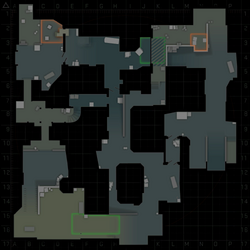Insightful Updates
Stay informed with the latest news and trends.
Dust 2 Decoded: Secrets of the Classic Map Revealed
Uncover the hidden secrets and strategies of Dust 2. Elevate your game with insider tips from the classic map that's changed esports forever!
The Evolution of Dust 2: A Historical Overview
Dust 2, one of the most iconic maps in the history of first-person shooters, has undergone significant changes since its inception. Created by David 'david' Johnston in 2001 for Counter-Strike 1.1, Dust 2 quickly gained popularity for its balanced design and engaging gameplay. The map's layout, featuring distinct paths for both teams and a central area that fosters intense firefights, made it a favorite among players. Over the years, with updates for various iterations of Counter-Strike, including Counter-Strike: Source and Counter-Strike: Global Offensive, the map evolved to adapt to the competitive scene while preserving its core essence.
In 2017, a major update revitalized Dust 2 once again, introducing improved graphics and environmental details that breathed new life into its familiar corridors and sites. This update not only enhanced visual fidelity but also addressed gameplay imbalances that had emerged over the years. Players welcomed the changes, as the map retained its classic feel while providing a fresh experience. As Dust 2 continues to be a cornerstone of the competitive Counter-Strike landscape, its historical significance and adaptability showcase the evolution of a map that has stood the test of time.

Counter-Strike is a popular first-person shooter game that focuses on team-based gameplay. Players can engage in various modes and strategies, including purchasing weapons and equipment. For an exciting experience, check out tradeit.gg case opening which adds an extra layer of fun to the game.
Top Strategies for Mastering Dust 2: Tips from the Pros
Dust 2 is a classic map in Counter-Strike: Global Offensive, and mastering it requires a combination of game sense, teamwork, and tactical execution. One of the most important strategies is understanding map control. Players should focus on crucial areas such as Long A, Mid, and B Site. Prioritize having one player watching Mid to gather intel, while others take control of Long A to pressure any opposing players. Use techniques like smokes and flashes to block enemy views and create opportunities for entry into sites.
Another key strategy is to utilize communication effectively. Teams that communicate well can execute complex strategies that keep the enemy guessing. For example, establish a default setup at the beginning of a round, where players are positioned to gather information and react accordingly. Use a mix of aggressive rushes and slow plays to confuse the opponents. Additionally, always maintain awareness of the enemy's economy and adapt your strategies based on their potential buys. Remember, mastering Dust 2 is not just about individual skill; it's about playing as a unit and executing strategies with precision.
What Makes Dust 2 the Iconic Map of CS:GO?
Dust 2, often referred to as de_dust2, stands as a testament to the lasting appeal of CS:GO. This map is renowned for its balanced gameplay, simple yet strategic layout, and its ability to cater to players of all skill levels. The design features a well-defined flow with clear choke points, allowing for intense engagements between teams. The two bomb sites, A and B, present distinct tactical challenges, keeping players engaged and strategizing through various playstyles, whether they prefer stealth, aggression, or coordinated team play.
Another factor contributing to Dust 2's iconic status is its cultural impact within the CS:GO community. The map has become a staple in professional tournaments and casual play alike, leading to memorable moments that are celebrated by fans. Additionally, its recognizable visuals—from the dusty streets of the Middle East to the intricate details of the buildings—create a vivid backdrop that enhances the gaming experience. In many ways, Dust 2 is not just a map; it is a symbol of the Counter-Strike legacy that continues to captivate players worldwide.